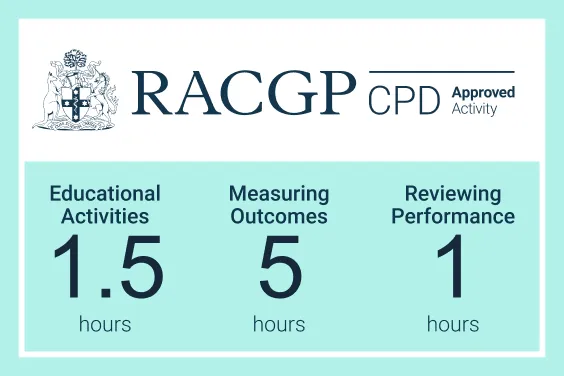Earn up to 15.5 CPD Hours across EA, MO and RP components
A unique, integrated CPD collection providing primary care clinicians with important updates on bronchiolitis, RSV, asthma and more. From diagnosis to management and referral pathways.
Acute Lower Respiratory Infections (ALRI) in infants & pre-schoolers
PRIMARY CARE CPD COLLECTION
Live webinar attendee




Earn up to 15.5 CPD Hours with this collection
A unique, integrated CPD collection providing primary care clinicians with important updates on bronchiolitis, RSV, asthma and more. From diagnosis to management and referral pathways.
Acute Lower Respiratory Infections (ALRI) in infants & pre-schoolers
PRIMARY CARE CPD COLLECTION
Live webinar attendee
Webinar countdown
This CPD collection examines the many and varied types and causes of ALRI (Acute Lower Respiratory Infections) in infant and pre-school aged children.
The four activities in this collection can be completed as part of a series or as individual learning activities in any order.
Comprehensive education for Primary Care

On-demand CPD activities
Earn 7.5 CPD hours: 1.5 hr EA, 5 hrs MO + 3 hours RP

Learning outcomes
The RSV Mother and Infant Protection Program (RSV-MIPP) - A practical guide to the GP's Role
- Describe RSV immunisation of pregnant women under the NIP to best cocoon their baby against RSV once born.
- List the indications for nirsevimab in infants born from the advent of the RSV-MIPP onwards across Australia.
- List the indications for catch-up nirsevimab in infants born before advent of RSV-MIPP and approaching their first RSV season across Australia.
- List the indications for catch-up nirsevimab in infants born before advent of RSV-MIPP and approaching their second RSV season across Australia.
- Determine correct dose of nirsevimab for eligible infants as above.
- Describe how practice systems can aid in identifying and recalling pregnant women for RSV immunisation and eligible infants as above for nirsevimab.
- Determine the resources and correct information for the RSV-MIPP according to the state you work in.

-v11.webp)


Earn 4 CPD hours: 1 hour EA + 3 hours RP

Learning outcomes
- Describe the salient features on history and examination of a preschool-aged child presenting with acute cough that facilitates a rational diagnosis and exclusion of common differential diagnoses.
- Summarise the pathophysiological and clinical differences between bronchiolitis and croup.
- Outline an approach to assessing disease severity in preschool children with bronchiolitis and croup.
- Detail an approach to diagnosing viral-associated wheeze, multi-trigger wheeze and asthma in young children.



-v11.webp)

Earn 6.5 CPD hours: 1.5 hours EA + 3 hours MO + 2 hours RP
Learning outcomes
- Describe the changing epidemiology, symptomatic presentations, and severity of RSV in the post-COVID restriction environment in Australia.
- Outline an approach to clinical and laboratory diagnosis of RSV in children and the requirements for infectious disease notifications and surveillance.
- Understand the pathophysiology of RSV in children, its impacts on at-risk populations, and capacity for long-term sequelae.
- List the evidence-based investigations and management of RSV in the community, and contrast that approach to the care given for severe disease in the tertiary setting.
- Summarise the emerging treatments and preventive measures for RSV that will become available in the Australian context in the near future

-v11.webp)



Earn 1.5 CPD hours: 0.5 hour (EA) + 1 hour RP
- The pathophysiology of RSV in infants
- Differentiating bronchiolitis from croup
- Key differential diagnoses
- Assessing disease severity
- Evidence-based management guidelines, including notifiable condition status
- Prognosis and parent education
Key learnings
This eLearning module provides important updates on the changing epidemiology and presentations of bronchiolitis in primary care. Including in-depth coverage of at-risk children, evidence-based management, and emerging options for mitigating RSV effects in the community.




-v11.webp)
Earn 3.5 CPD hours: 0.5 hour (EA) + 3 hours MO
- Pathophysiology of RSV
- Seasonal epidemiology
- Mechanical disadvantage of the respiratory system in under-2-year-olds
- Long-term sequelae of RSV infections in children under 12 months of age
- Risk factors for severe disease
- Managing risk factors and risk of early-life infection
Key learnings
A valuable update on the emerging trends in RSV epidemiology, severity and evidence-based management strategies. This eLearning module will enable GPs to ensure timely identification of this illness and to direct care to the safest and most appropriate approaches, based on the symptoms of the child, and their at-risk characteristics.
A valuable companion to the accredited RSV collection, this narrated consultation simulation steps you through an effective approach to counselling parents of young children presenting with respiratory infections.
Duration: 9 mins
The GP's Role in RSV Counselling: A Case Study
BONUS CONTENT
Ratings and reviews












Educational Activities (EA) hours
Your EA hours are recorded as you learn in Praxhub.
RACGP and AMA/CPD Home members will have their EA hours lodged for them. All other users, please use the provided certificate of completion (available immediately after completion of the EA activity in your Praxhub History section) to self-record your hours in your nominated CPD body.
Measuring Outcomes (MO) and Reviewing Performance (RP) hours
RACGP members who submit their MO and RP activities via the provided online form will have their hours lodged for them. For all other users, please complete the provided downloadable templates and self record via your nominated CPD body.
Praxhub is a CPD education Major Provider under the RACGP CPD Program.
Continuing Professional Development (CPD) Details
What do 'EA', 'MO' and 'RP' Stand for? See definitions


- - please select -
- General Practitioner (RACGP)
- General Practitioner (ACRRM)
- Other Specialist
- Allied Health including Nurses
- IMG
- Industry Representative
- Other
Please enter your details to attend.
Once completed, please check your email for reminders.
* indicates required field
Register to attend the free webinar
Praxhub would like to acknowledge Sanofi for its support of this education. The sponsor has provided no input into the content of this activity.
© Praxhub 2025, all rights reserved.
Definitions
- 'EA' stands for 'Educational Activities'
- 'MO' stands for 'Measuring Outcomes'
- 'RP' stands for 'Reviewing Performance'
Learn more about minimum EA, MO and RP requirements for General Practictioners.

-v5.svg)
-v5.svg)











